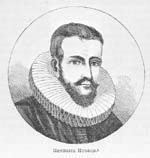|
History
Age of Exploration (16th-17th centuries)
A driving force for the exploration of the Arctic was the desire of European monarchs to find an alternate trading route to China, via either a Northwest Passage along the coast of North America, or a Northeast Passage along the coast of Siberia. A number of expeditions sought such routes in the 1500-1700s, which resulted in the discovery of much of northern North America, but no viable passage.
In 1524, under the direction of the king of France, Giovanni
da Verrazano took the entrance to Hudson River (now New York
City) to be the entrance for the passage, and ten years later
Jacques Cartier likewise discovered the St. Lawrence estuary.
The first Englishman to seek the passage was Martin Frobisher
in three voyages up to 60°N between 1576 and 1578. On his first
voyage, relations with the natives quickly became hostile, and
a prisoner was brought back to England. John Davis followed
in 1585, 1586, and 1587 charting the strait west of Greenland
that now bears his name.
 |
 |
Young Henry Hudson
© Public Domain
Image courtesy National Archives of Canada. |
|
Financed by the Dutch, in 1609 the Englishman Henry Hudson followed
Verrazano's course, and explored the river that now bears his
name. The following year he discovered the vast inlet (now called
Hudson Bay) beyond Davis Strait. Robert Bylot and navigator
William Baffin undertook two expeditions in 1615 and 1616, exploring
the north coast of Greenland up to 78°N and then along the Canadian
archipelago to Lancaster Sound. Convinced it was only a bay,
Baffin concluded that no Northwest Passage existed, and interest
in searching for one waned for the next 200 years.
Other explorers were drawn to search for a Northeast Passage
connecting the White Sea and Bering Sea. The Dutch navigator
William Barents led three expeditions east of Novaya Zemlya,
and on the third expedition in 1596 claimed Spitsbergen. From
the early 16th century, Russian navigators used shallow draft
vessels with reinforced bottoms (kochi) to cross the Kara Sea
and explore the Ob and Yenisey rivers. Yermak's Cossacks expanded
the Russian presence eastward, crossing the Ural Mountains in
1581. In 1601, Mangazeya town was founded at Taz River between
the Ob and Yenisey rivers, and dozens of boats from Pomor lands
began annual navigations.
Throughout the first quarter of the 17th century, a great number
of merchants, trappers and Cossacks moved east and north, settled
East Siberia and explored the northern Siberian coast. In 1610,
the Yenisey River was navigated to its northern estuary and
the coast to the estuary of the Pyasina was explored. Cape Chelyuskin
was overtaken from the west in 1617, Yakutian Cossacks Ivan
Rebrov and Ilya Perfilyev headed down to the Lena River estuary
and made the first sea voyage to the Yana River in 1633, and
in 1639, the Pacific shore was reached by Ivan Moskvitin and
his detachment of Cossacks. In a 15-year timespan, all Siberian
river estuaries from Khatanga to Kolyma had been discovered
and a large part of the Northeast Passage from the White Sea
to Kolyma estuary had been covered. Semen Dezhnev traversed
the final segment in 1648, leading 90 Cossacks on a journey
from the Kolyma to Anadyr Rivers, discovering the strait between
Asia and America (proving that they were different continents)
and passing the cape which now bears his name.
References:
Francis, D., Discovery of the North: The Exploration of Canada's
Arctic, Hurtig Publishers, Edmonton, Canada, 224 pp., 1986.
Imbert, B., North Pole, South Pole: Journeys to the Ends
of the Earth, Harry N. Abrams, Publishers, New York, 192
pp., 1992.
 Previous Chapter
Next Chapter Previous Chapter
Next Chapter

|



